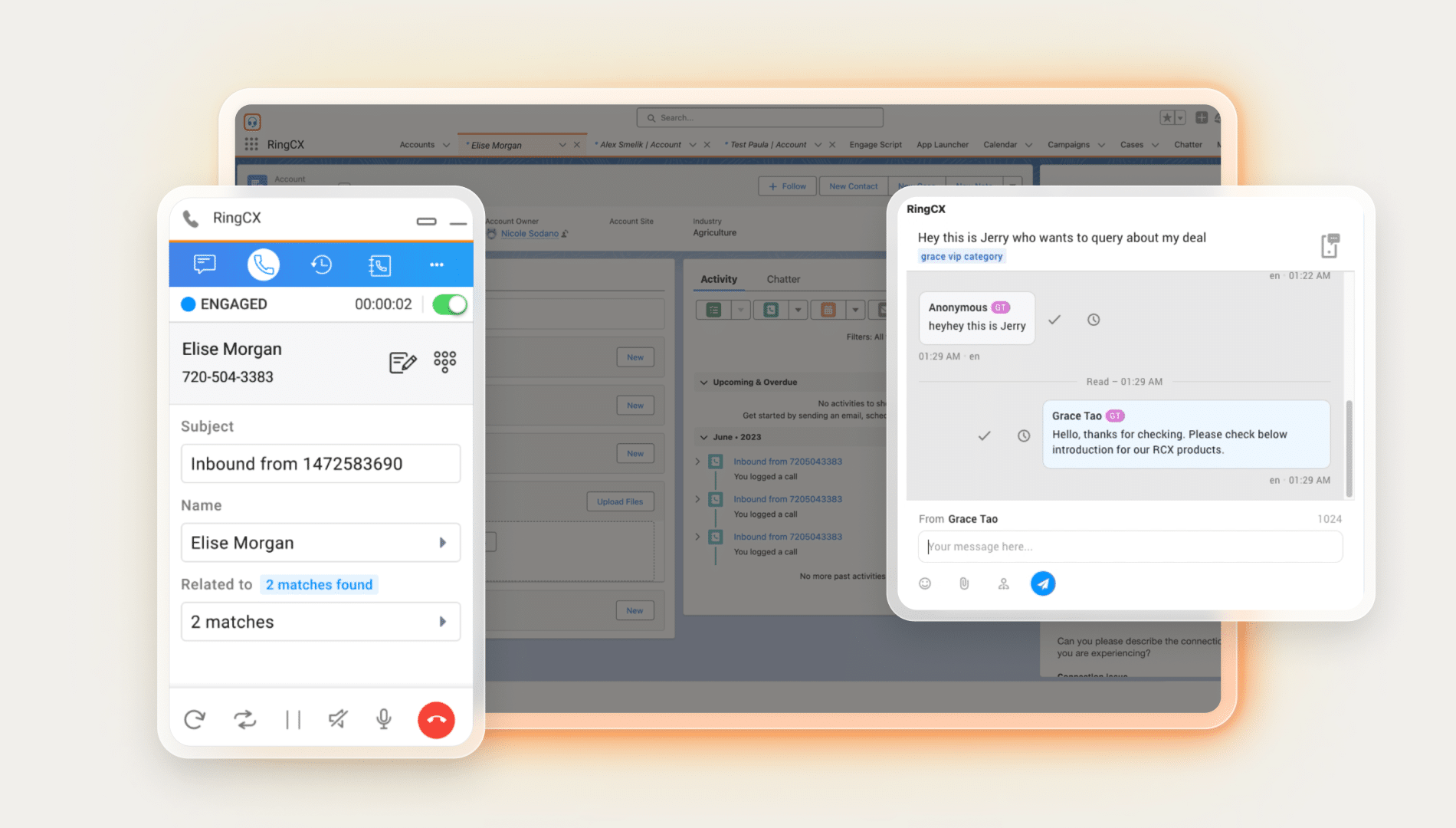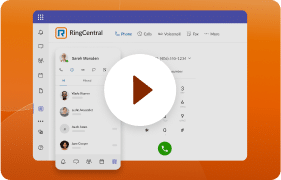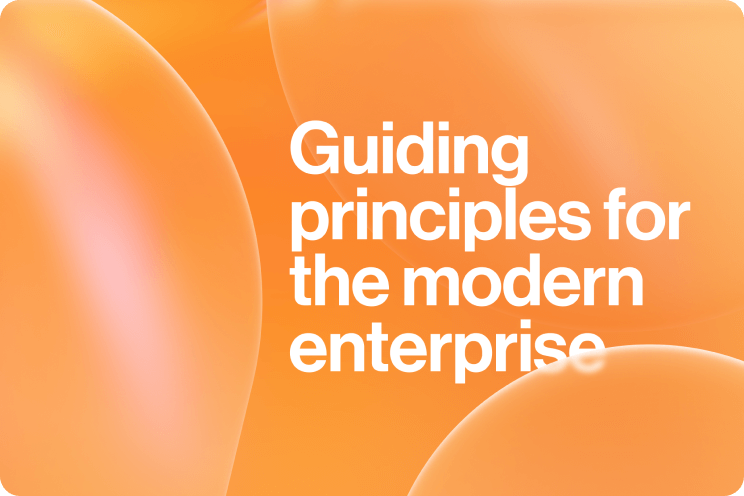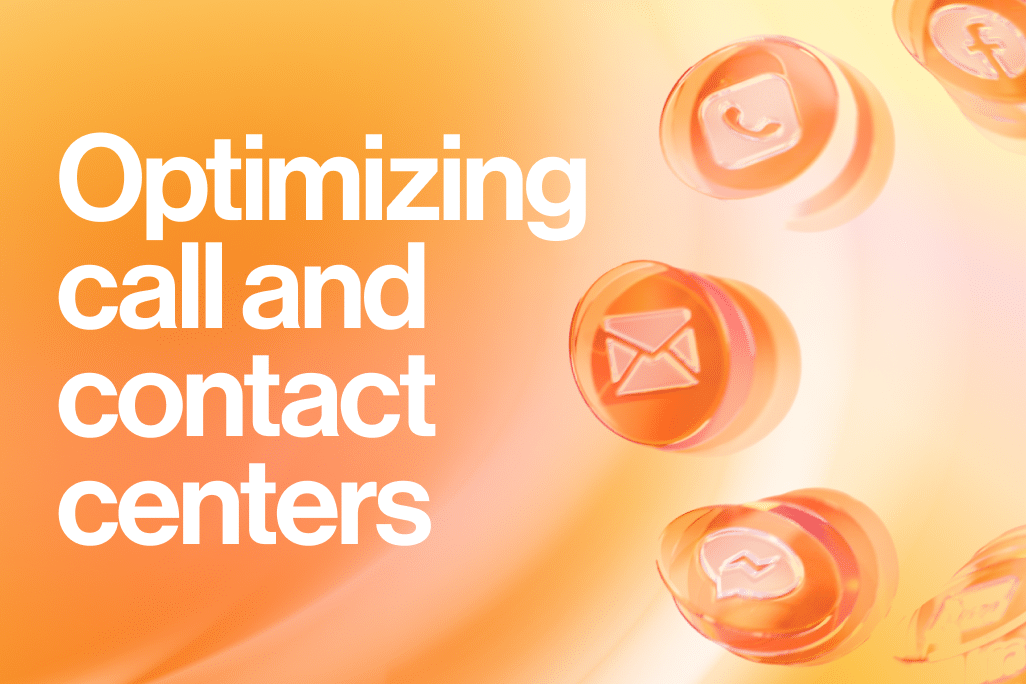Customers increasingly expect a seamless experience regardless of how they reach out to your business. Unless you operate an omnichannel contact center, it’s almost impossible to deliver.
Instead of the frictionless service they desire, customers too often find themselves being passed from agent to agent, explaining the same situation over and over. It’s repetitive. It’s tedious. It’s a good enough reason to lose faith in any company and take their business elsewhere.
A fully optimized cloud-based omnichannel contact center solution connects everything from live chats to social media, and SMS to your CRM system, creating that seamless customer experience and empowering agents to hit KPIs.
Long story short, the customer journey is one of the most important aspects of your business and an omnichannel contact center ensures you can meet customers where they are.
But what actually is it? Read on, and find out, or skip ahead, if you like:
- What is an omnichannel contact center?
- The benefits of omnichannel contact centers
- Omnichannel contact center software features to look for
- Beyond omnichannel contact center features: What else to expect from a software provider
- Tips for implementing an omnichannel strategy
- Considerations when setting up an omnichannel contact center
- Best practices for incorporating omnichannel contact centers
- Omnichannel contact center FAQs
What is an omnichannel contact center?
An omnichannel cloud contact center is a customer service platform that allows agents to seamlessly switch back and forth across channels when seeking support. It’s also sometimes referred to as cloud-based contact center software that handles customer interactions across multiple channels.
Contact center vs call center
Unlike a call center, a contact center handles a wide range of communication channels—not just phone calls. Customers can reach out to a business over the phone, of course, but also via live chat, social media, email, and more.
Most companies today run contact centers, not call centers. However, sometimes there’s confusion between the two terms, with people still using the older term “call centers” to describe those that offer other channels. You might even hear someone use the phrase “omnichannel call center,” but technically there’s no such thing—if it’s omnichannel, it’s a contact center.
Contact center agents typically have the following responsibilities:
- Handling inbound and outbound calls
- Verifying customer information
- Resolving customer complaints and providing general customer support
- Responding to emails and SMS messages
- Staffing live chat channels
- Social media support (on channels such as WhatsApp and Instagram)
Most contact centers work using VoIP-based software which combines interactive voice response (IVR), call screening, voicemail, predictive dialer, call recording, SMS, conference calling, video calling, and more to ensure top quality customer experiences and aid customer retention.
⭐ Take your contact center to a whole new level ⭐
Next-Gen Cloud Contact Centers for Dummies®, RingCentral Special Edition eBook
Omnichannel vs multichannel contact center
So, what about omnichannel? Where does that come in and what does it mean? That’s most easily understood when you compare omnichannel and the similar, but different, “multichannel”.
An omnichannel approach is a cross-channel strategy that organizations use to streamline all the channels that they provide customer support on in order to create a better customer journey. Communication channels and their supporting resources are integrated and work together as part of one greater whole.
A multichannel approach, on the other hand, also involves multiple channels—the difference is an agent can’t see every single channel’s conversations in one place. For example, with an omnichannel solution, an agent can see from their dashboard that a customer who just called has already reached out twice in the past month—once on email and once on Facebook. With a multichannel contact center, the agent wouldn’t be able to see these different interactions in one place.
The omnichannel concept can apply across many different areas of business. An omnichannel shopping experience, for example, might connect the online, in-store, and in-app experience for a customer so they can earn reward points, access relevant product tutorials, or find products more easily.
Put simply, omnichannel means that every cog in a machine connects. In a contact center, that means customers can seek support by seamlessly switching back and forth across channels, whether that’s:
- Phone calls
- Video calls
- SMS
- Social media
- Live chat
- Mobile apps
- Self-service channels like FAQs or knowledge bases
Let’s say Shiv has ordered a new phone online, but it’s damaged. She’s called her network provider a few times and is calling again to resolve the issue. The omnichannel cloud contact center software the phone company uses tracks her details and establishes that Shiv has called in several times already. The agent knows Shiv has an open case, saving her the need to repeat herself.
What if Shiv needs to show the damages? Using an omnichannel cloud contact center, the agent can switch from phone call to text, allowing Shiv to take a photo of the phone and send it over.
Hosted, cloud-based contact center software handles Shiv’s interactions across multiple touchpoints, ensuring that no data is left behind.
Why use an omnichannel contact center?
So, now that you know the meaning of omnichannel contact centers, why would you choose to use one?
Well, it’s all about providing a smoother customer experience. The omnichannel model allows customers to contact you via their preferred channel and device, at any time.
Because customers and agents can move seamlessly between channels as they interact, there’s no risk of conversational threads going astray. With more contact options—including self-service—you can decrease call queues and wait times, reducing frustration for everyone.
Offering more options also encourages people to get in touch, which enables you to gather more data. The more you communicate with your customers, the more you learn about them—and you can use this information to create personalized experiences and improve products and marketing campaigns. Data from all channels is in one place for easy access and analysis.
Omnichannel contact centers boost your reputation as customers know they’re talking to a professional and efficient business that cares about their needs. It also future-proofs your business, as more and more customers are keen to use a range of channels.
The benefits of omnichannel contact centers
We’ve discussed a few of the benefits, but let’s dig a little deeper and find out exactly what an omnichannel contact center can do for you.
Better customer experiences
The main aim of omnichannel cloud contact centers is to boost the customer experience. The contact center functions to communicate with your customers. So, it should communicate in the very best way.
Customers hate sitting on hold. It can be incredibly frustrating. However, if they’re able to communicate with you via chat, SMS, or social media, this eliminates waiting times.
They also hate repeating their problem over and over again to different agents. When an omnichannel solution is in place, your customer service agents are more in the know and don’t need to ask repetitive and tedious questions.
All in all, this creates a better customer experience, creating more loyal customers.
Stay informed with RingCentral
Subscribe to our emails for the latest blogs, events, and exclusive content on AI-powered communication solutions. Stay ahead with insights and tips from the leader in trusted AI communications.
Stay informed with RingCentral
Improving agent efficiency
A good omnichannel contact center solution doesn’t just benefit customers—it makes your agents’ jobs easier too.
By connecting and seamlessly integrating your communication channels, it gives agents all the information they need right at their fingertips. There’s no more siloed data or digging through different platforms to find past customer interactions.
The best contact center solutions will also integrate with your CRM platform and other business tools. That means agents have a wealth of information all in one place to work as efficiently as possible. RingCX and RingCentral Contact Center, for example, have over 300 pre-built integrations .
Visibility into social media conversations
Consumers are all over social media. When they have complaints, they don’t just call in or email anymore. Often, especially with Gen Z customers, social media is the first point of contact.
This is a huge reason why an omnichannel contact center is so beneficial—it can connect all your social media accounts and conversations in one place.
By integrating your social media platforms with other support channels like phone and SMS communication, you can make it easier for agents to go through the full customer journey and see where and when customers previously contacted you.
Whether that’s on Facebook Messenger or Instagram Live chat, an omnichannel solution can help you connect to customers quicker than ever before.
Creating a global voice
Business continuity is key. A cloud contact center creates the opportunity to create a global voice for your business.
For companies with agents in different regions, an omnichannel contact center that’s powered by AI can help train your agents to use the same language and messaging across all offline and digital channels.
RingCentral’s platform, for example, has AI-powered speech analytics, along with workforce management and performance management features.
Features of omnichannel contact center software

There are a lot of omnichannel contact center platforms to choose from. How can you ensure you select the right one for you? One first step is to check that any potential software includes the must-have features that your business can’t do without.
Before committing to any omnichannel contact center solution, make sure it has:
Omnichannel routing
Omnichannel routing means connecting customers with the right agents, no matter whether that’s through social media, web chat, or text messages.
Just like with call routing, you can set up rules so that interactions are passed quickly to available agents or those with specific skills to resolve an issue. This leads to shorter handling time and improves first-contact resolution.
Agent management
A key part of running an efficient contact center is optimizing agent schedules and preventing long hold times for customers. Omnichannel platforms give you the data you need to schedule staff more effectively, factoring in peak times and seasonal spikes in call volume. This also increases agent productivity and minimizes agent effort.
Real-time insights
You can improve sales and service with real-time reports and data monitoring to ensure that your business performs as well as possible. Monitor customer preferences and pain points, and use the data to optimize your processes and provide extra coaching to agents where needed.
AI-powered assistance
Thanks to artificial intelligence, you can provide real-time guidance to agents during interactions with agent assist and live coaching tools, and automate processes like call scoring.
RingCentral also gives you AI-generated call summaries and transcripts, plus sentiment analysis to tell you how customers really feel.
Wide range of supported channels
Omnichannel contact center solutions seamlessly connect any and every communication channel that’s important to your customers. This means you can ensure consistency across interactions, and agents have easy access to previous conversations and customer history.
Self-service options
You’ll want your solution to come with features like Interactive Voice Response (IVR), auto-attendant, and chatbots so that customers can self-serve where possible. While these tools gather information and handle simple inquiries, they free up agents for complex tasks, meaning faster response times for customers.
Native integrations with other tools
Connecting your other business tools makes for a true omnichannel solution. Alongside CRMs, ticketing tools, and online calendars, you can also integrate workforce management solutions, email, SMS, and social media platforms. Look for APIs to create your own integrations.
Scalability
Cloud-based solutions allow agents to access the system from anywhere, which enables remote working and global recruitment (and no expensive on-premises equipment). You can adapt to customer demands and seasonal fluctuations by easily onboarding new agents or adding extra features.
RingCX and RingCentral Contact Center can connect your contact center agents with customers on their channels of choice, keeping your customers happy and creating a more streamlined customer experience.
Beyond omnichannel contact center features: What else to expect from a software provider
As important as securing the best omnichannel contact center features is, the feature set that a provider can offer isn’t all you need to think about.
When choosing between software solutions, make sure to also consider:
- Ease of deployment – A platform can boast all the features in the world, but if your support teams can’t work out how to use them, they’re no good to you. Look for a solution that makes deployment a breeze and that you can get up-and-running in days rather than weeks.
- Ease of use – Your chosen omnichannel contact center solution should be as intuitive as possible. You want your agents to be able to complete their day-to-day tasks simply and swiftly. If your solution integrates seamlessly with your internal communications tool—like RingCX and RingEX do—all the better.
- Availability of support – No matter how intuitive a solution may be, you’ll likely need support from your provider from time to time. Make sure you can reach them when you need to and how you need to.
- Reliability and security – Check out any prospective provider’s uptime guarantees to ensure your software will always be available to you. If you’re in a regulated industry like healthcare, ensure your provider has the requisite security and compliance certifications too.
Tips for implementing an omnichannel strategy
First things first, what actually is an omnichannel strategy? It’s important to note that an omnichannel strategy isn’t just about investing in the right software or being on every single channel available. Here’s how to get started with implementing an omnichannel strategy into your contact center:
1. Do your customer journey mapping
A customer journey map is a visual story of your customers’ interactions with your brand. Creating one helps you step into a customer’s shoes and see your business from the customer’s perspective.
It’s crucial as a first step towards adopting a true omnichannel approach. Here are some customer journey mapping tips:
- Do your research: Customer mapping relies on research. You need to drive the results you want. So, firstly gather as much data as possible about your customers. Where are they coming from? Which channels are most popular? Do they stay with you after the initial purchase?
- Run surveys and tests. If you have the bandwidth and resources, it’s always best to hear directly from your customers when building your map. You could put a heatmap on your website or survey existing customers, but it will be valuable to see how your customers’ journey actually looks, compared to what you see in your own analytics tools.
- Interview your team: Typically, your frontline staff will know your customers best. Talk to your agents and contact center leaders to get their perspective on how your customer journey currently looks.
- Measure it: Be sure to include KPIs or metrics at each step in the journey to help clarify performance gaps.
- Prioritize: It’s impossible to tackle everything at once. So, once you’ve completed the journey map, decide which pain points are the most important. From your list, you can create a productive and realistic roadmap that actually gets results.
2. Decide how many channels you want
Sure, all of them would be ideal, but few companies have the resources to have a huge presence on every single contact center channel. It’s often better to offer a few and do them right.
Establish your priorities. Do you want to get SMS right first before moving onto social media? Do you want to nail live chat before exploring automation via chatbots?
Having your customer journey map on hand will help you here. It’ll tell you what’s most important to your customers, and help you prioritize the right channels.
3. Address internal barriers
You don’t want to implement omnichannel services if your contact center is struggling with other factors like staffing or legacy technology. Make sure everything is streamlined and working well first.
4. Balance automation and human engagement
An optimal omnichannel customer experience is all about understanding how to match customer expectations with the most effective response. Some types of questions can be handled by chatbots, others can’t.
Get the balance right. Again, your customer journey map can help give you insight into how customers reach out to you and for what reasons. Where can automation enhance that and where is the human touch needed? If customers tend to call you about more complex troubleshooting questions, but use live chat for basic issues, you might want to keep your agents on the phones, and start experimenting with chatbots on live chat only for now.
5. Buy the software
Buying the software should be the final step when going omnichannel. Take the time to research the options and find the best software that addresses your specific customer journey’s gaps and needs. Don’t forget to assess your budget and make sure you’ve accounted for hidden costs and onboarding requirements (like how much time is needed to get started on the new platform).
Considerations when setting up an omnichannel contact center
Setting up an omnichannel contact center doesn’t have to be an onerous task (especially with a user-friendly solution like those offered by RingCentral). But here are some things to bear in mind before you get started:
Business needs and goals
When you’re deciding on your requirements for an omnichannel contact center platform, you need to have a handle on your business goals and customer needs.
What exactly are you aiming to achieve with this solution? Are there specific metrics you want to improve, such as average handle time or customer retention? Which metrics will you use to measure progress and success?
Technology and integration requirements
Think carefully about the features you’ll need to meet your goals and enhance the customer experience. Look for tools such as smart routing, power dialers, and AI automation, and make sure it includes self-service options.
A CRM integration is a must-have, and you’ll also want the system to connect with your other business applications.
Budget and ROI
Your budget is one of the key considerations, so think about the overall costs of running an omnichannel contact center—including training and future upgrades. It’s a good idea to figure out the potential return on investment (ROI) to decide whether or not a solution is viable.
The advantage of a cloud-based platform is that you won’t have any upfront expenditure or maintenance costs, just a monthly or yearly subscription fee.
Agent training and scheduling
You’ll need to factor in the resources required for training your agents on using the new technology and improving their skills and knowledge.
How will you implement training programs without any gaps in service? What type of training will you offer—workshops, 1:1, or online learning? You should also come up with a workforce management strategy to ensure the contact center has the right amount of staff at all times.
Consistency and quality
With an omnichannel approach, you have the opportunity to maintain a consistent brand voice across all your channels. We’re not just talking about the fonts and colors you use—it’s also about tone of voice and messaging. How will you make sure agents adhere to this? Will you use scripts for calls?
Remember that you need to offer a consistent customer service experience across different devices, so run some tests to make sure things like visual elements are properly optimized.
Best practices for incorporating omnichannel contact centers
Now let’s look at some top tips for incorporating and running your omnichannel contact center and making the most of its smart features.
Phase the implementation
Whether you’re migrating from a different system or setting up a contact center from scratch, it’s best to implement the new platform in stages.
That way, there’s less risk of a complete failure, as you can check that each element is working properly before moving on to the next. Start with the channels and features that have the most impact on your business.
Prioritize the right channels
Use the customer journey map you created earlier, and identify the channels that customers use the most.
Then, you can make sure you’re devoting the right amount of resources to these. It’s worth focusing on social media, as more customers are using this channel as a way to get in touch with businesses. Don’t forget that they’ll expect even faster responses with this method!
Make full use of AI and automation
Automated and AI-powered tools are a real bonus for contact centers as they save time and reduce operational costs. You can use them to automatically route inquiries to the right place, gather essential information from customers before passing them to an agent, and set up automated responses telling customers their message has been received.
These tools are often capable of resolving basic customer issues, but make sure your chatbot or IVR “knows” when to escalate the conversation to a live agent.
Personalize your service
Omnichannel contact centers enable you to collect more customer data than ever before, and you can use this to personalize every interaction for maximum customer engagement.
With all channels connected to a single platform, agents can instantly access customer history and preferences, and tailor their conversations accordingly. Customers really appreciate being addressed by name and not having to repeat details from previous interactions.
Keep monitoring progress
It’s vital that you evaluate the performance of your solution by monitoring key metrics, customer feedback, and agent engagement. Use the data to identify any problems, as well as opportunities to improve workflows through continuous optimization.
Keep a close eye on customer behavior—are their channel preferences changing over time? You can use surveys such as CSAT (customer satisfaction), NPS (net promoter score), and CES (customer effort score) to assess how happy they are with your service.
An omnichannel contact center is how to futureproof your business
Today’s consumers expect businesses to meet them on their preferred channels and deliver a seamless customer experience no matter which of those channels they use.
If your business isn’t supported by the right omnichannel contact center solution, delivering that level of customer experience is nigh-on impossible.
If you’re looking for an omnichannel contact center solution, get a demo to learn more about RingCX and RingCentral Contact Center!
Omnichannel contact center FAQs
What is the difference between multichannel and omnichannel contact centers?
People tend to get multichannel and omnichannel muddled up.
As you know, omnichannel is a customer service function that allows customers to seamlessly switch back and forth across channels.
Multichannel is the term for a number of different channels, which run on different systems. Essentially, the difference is that omnichannel contact centers connect and optimize every element, whereas multichannel contact centers don’t.
Let’s take a closer look at the key differences:
| Multichannel contact center | Omnichannel contact center |
| Uses multiple channels to communicate with customers | Uses multiple channels for customer communication |
| Each channel provides different services | Channels can provide the same service |
| Each channel runs separately from the rest | Channels run together and cooperate |
| Every channel might use different software | All channels are run on the same software |
| Key information about a customer can be easily missed | Key information and data is tracked, ensuring that information isn’t missed |
| Customers have to repeat themselves to different agents via separate channels to solve a problem | Agents access all customer information, so the customer doesn’t have to repeat themselves |
What is the meaning of “contact center solutions”?
Contact center solutions or call center solutions are simply other terms for software alternatives. They’re often referred to as “solutions” because the software provides a solution for all your contact center problems.
How long does it take to create an omnichannel contact center?
When implementations are planned using the right omnichannel strategy, it shouldn’t take too long to make the switch to omnichannel.
Most implementations take a few weeks, with proper planning. However, this also depends on the size of the contact center. Contact centers with a large number of agents will require more planning and preparation.
How do I know if my business needs an omnichannel contact center?
Any business that wants to provide a seamless experience across channels and improve its customer relationships can benefit from implementing an omnichannel contact center. But there are a few questions to ask yourself:
- Are you struggling to manage high call volumes?
- Is it tricky to find data from previous customer interactions?
- Do you need to improve productivity and efficiency?
- Are you seeing low levels of satisfaction among customers and support agents?
If you answered “yes” to any of the above, then the omnichannel approach is a good fit for your business.
What is the meaning of omnichannel customer service?
Omnichannel customer service means that your contact center supports its customers across multiple channels—including phone, messaging, chatbots, video, and social media.
All those channels are connected so that agents can view all previous interactions and customers get a consistent experience, no matter which channel they use.
When customers contact you, they can pick the channel that’s most convenient for them. And it’s easy to switch between channels (and devices) without losing access to the conversation thread.
How do I monitor my contact center with omnichannel supervisors?
By using built-in dashboards, omnichannel supervisors can view all ongoing conversations as well as reviewing interactions later.
They’ll get a picture of performance across the whole contact center. They can listen in on calls, read transcripts, receive alerts about negative sentiment, and step in to help an agent who’s struggling.
Plus, the system displays key metrics like call volume, wait times, and first-call resolution—invaluable for staff scheduling and delivering training to the right people.
Originally published Jun 20, 2024, updated Mar 26, 2025












